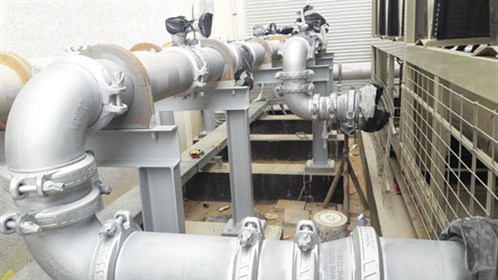Maintenance and Reliability: Looking beyond processing efficiency to optimize operations
When facility owners think about plant optimization, the emphasis often is on maximizing throughput and, in many cases, that means focusing on processing equipment. While production efficiency is essential to profitability, there are other contributors to optimized operations—including reliability, availability and sustainability—that apply to every facet of operations.
Utility piping and fire safety systems, which are essential to safe and continuous operations, can have a considerable impact on plant uptime, illustrating just how critical they are to maintaining productivity.
Scope of impact. Piping for utility and fire safety systems often makes up more than one-third of the total piping in a gas processing facility and includes a broad range of systems from utility air, compressed air and instrument air, to nitrogen, inert gases, lube oils, glycol and water.
A newbuild LNG facility requires all of these utility and safety systems. Taking into account only some of these essential functions, that could amount to thousands of linear feet of pipe, including small-diameter pipe for fire safety systems and large-bore piping systems in excess of 24 in. for water and glycol, inert gas and air. Pipe material can be carbon steel, stainless steel or non-metallic, in applications that require flexibility or chemical resistance and in operations where wide temperature variations occur.
To date, joining methods for these piping systems have included welding and flanging for steel pipe and heat fusion for HDPE, but the inherent drawbacks of these approaches are significant, and all of them make installation and maintenance costly and time-consuming.
Considering a different approach. Although gas processing facilities have relied on flanging and welding for steel piping in utility systems, these joining methods are not ideal and often are not cost-effective. The shortcomings are well known, but there is a reluctance to move away from a solution that works. Achieving greater efficiencies, however, means working in a different way and recognizing the value of a proven solution.
For more than a century, grooved mechanical joining solutions have been used across pipe materials and sizes to provide a solution that mitigates risk, maximizes productivity and minimizes construction schedule. This proven technology, adopted in a variety of chemical and energy sectors including chemical, petrochemical and LNG, is changing the way piping systems are designed, installed and maintained.
The coupling design is simple and consists of four basic components: grooved pipe, coupling housings, bolts and nuts, and the engineered elastomeric gasket. The gasket engages the full pipe end circumference, fitting securely into the grooves to create a unified joint, which is then enclosed by the coupling housings and bolted on. The housings are installed using simple hand tools, and as the bolts and nuts are tightened, the elastomer gasket creates a triple-seal effect on the pipe ends. The gasket sealing lips press down onto the pipe ends when the system is pressurized, creating a leak-tight joint.
The couplings, which can be installed up to 10 times faster than other joining methods, require only a visual inspection to verify proper makeup. If the coupling needs to be reinstalled, the process only takes a matter of minutes. Couplings are manufactured as rigid or flexible joints for a range of applications and can be installed on nearly any size pipe.
Installing grooved couplings is straightforward because assembly requires only standard hand tools. On a recent project, more than 120 pipefitters were trained to install mechanical grooved couplings in less than 20 minutes and were immediately able to execute the installation. On average, even for these first-time installers, it was possible to install the grooved mechanical system in half the time it would have taken to weld.
Furthermore, the visual inspectability of the mechanical grooved couplings enabled these installers to verify that every joint was properly made up, ensuring system reliability without the additional quality control documentation that would have been required for weld inspection.
Addressing challenges, adding value. The benefits of grooved mechanical couplings are being realized on projects in a range of applications both inside and outside the facility.
In a recent LNG facility expansion, owners encountered a problem transitioning a carbon steel pipeline from aboveground to belowground, where it would be buried in unstable soil. Experts had predicted that over the course of 2 yr, the pipe would experience 5 in.–6 in. of movement caused by settling, which exceeded the performance capability of the previously installed flanged joints. Resolving this problem was simple, using flexible grooved couplings installed in a series at the transition point. The mechanical couplings accommodated the dynamic movement, and because they are easy to install, the joints could be made up and inspected quickly to keep the project on track. This solution maximized onsite productivity throughout installation and will deliver additional gains down the road when inspections need to be performed or maintenance is required.
Grooved couplings reduce maintenance downtime and, with a union at every joint, simplify system access. Couplings are easily disassembled and removed from the joint and can be reassembled as quickly as the initial installation. The design simplifies maintenance, repair, and future expansions or modifications. When properly installed and operated within design specifications, grooved mechanical couplings are designed to last the life of the system (FIG. 1).
 |
| FIG. 1. Grooved mechanical couplings not only deliver installation and maintenance efficiencies in gas processing and LNG facilities, but also improve site safety and sustainability. Photo courtesy of Victaulic. |
Facilitating the move toward net zero. Grooved couplings also help owners drive toward net-zero goals by decreasing emissions and reducing the carbon footprint of operations. They do not generate the byproducts and fumes that are produced by alternative joining solutions. Also, because hand tools can be used for installation, assembling the couplings requires no gas- or electric-powered tools, so no CO2 emissions are introduced by the power source.
These couplings also are proven to reduce fugitive emissions. The gaskets used in proprietary grooved couplings were tested at a third-party laboratory to assess their efficacy compared to standard ANSI Class 600 flanges. High-pressure helium was applied to four coupling assemblies and four flange assemblies and thermally cycled to determine the effects of elevated temperature on emission rates. The couplings and gaskets exceeded the performance of standard flange connections, providing consistent and uniform sealing at both the temperature and pressure extremes of the tests.
Enabling technology changes the status quo. Profitability depends on performance, and that means much more than improving throughput. Capturing efficiencies also means ensuring reliability and system availability and using technologies that enable sustainable operations.
Grooved solutions deliver on every requirement, and successful installations prove that they can improve operations in the gas processing sector. GP
 |
ADAM BOZICK is the Divisional Manager for U.S. Oil, Gas, and Chemical at Victaulic. His responsibilities span the upstream, midstream water management and downstream sectors. His areas of expertise include fabrication and modularization, ESG and site constructability. Mr. Bozick is an active member of CII and the Rice Engineering and Construction Forum and holds a BS degree in engineering from Lafayette College and an MBA degree from Moravian College.




Comments